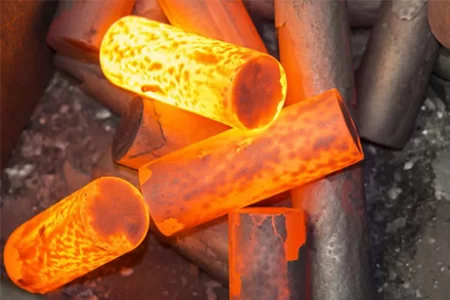Hot forging is a manufacturing process that changes the shape and properties of metal by heating it and applying pressure in a forging device.

Hulk Metal Forging News
Share what's new
Forging: What Is It? What Are The Different Types of Hot Forging?

Hot forging is a manufacturing process that changes the shape and properties of metal by heating it and applying pressure in a forging device. It is widely used in various industrial fields, such as Cable & Wire Grips, Trailer Accessories, Building Hardware, and Metal Exterior Accessories For Car, SUV, Truck, etc. This article will take a detailed look at the materials commonly used in the hot forging process, including carbon steel, alloy steel, and stainless steel, and explore the two main processes of hot forging: open die forging and closed die forging.
Material Introduction
In the hot forging process, it is crucial to choose the right material because the characteristics of the material directly affect the performance and application of the final product. Commonly used hot forging materials include carbon steel, alloy steel, and stainless steel.
Carbon Steel
Carbon steel is an iron-carbon alloy with a carbon content between 0.02% and 2.14%. According to the carbon content, carbon steel can be divided into low carbon steel (carbon content less than 0.25%), medium carbon steel (carbon content 0.25% to 0.6%), and high carbon steel (carbon content above 0.6%).
Low-carbon steel has high toughness and plasticity and is suitable for manufacturing parts that require high ductility and toughness. Medium carbon steel strikes a balance between strength and toughness and is often used to manufacture mechanical parts and high-strength fasteners. High carbon steel is suitable for making tools and knives due to its high hardness and wear resistance.
Alloy steel
Alloy steel is a type of steel that has other elements (such as chromium, nickel, molybdenum, vanadium, etc.) added to carbon steel to improve its performance. Different alloying elements give steel different properties. For example, chromium and nickel can improve the corrosion resistance of steel, molybdenum can increase the strength and hardness of steel, and vanadium helps to improve the toughness and fatigue resistance of steel.
Alloy steel is widely used in areas that require high strength, high hardness, and high wear resistance, such as lifting devices.
Stainless steel
Stainless steel is a steel alloy mainly containing chromium and nickel, which has extremely high corrosion resistance. This is because chromium reacts with oxygen in the air to form a stable passivation film that prevents further oxidation. According to its organizational structure and properties, stainless steel can be divided into austenitic stainless steel, ferritic stainless steel, martensitic stainless steel, and duplex stainless steel.
Austenitic stainless steel (such as 304, and 316) has excellent toughness and corrosion resistance and is widely used in food processing, chemical equipment, and architectural decoration. Ferritic stainless steel (such as 430) has a low cost and is suitable for manufacturing home appliances and automotive interior parts. Martensitic stainless steel (such as 410, 420) is often used to manufacture knives and medical devices due to its high strength and wear resistance. Duplex stainless steel combines the advantages of austenite and ferrite, has high strength and excellent corrosion resistance, and is suitable for marine engineering and petrochemical fields.
Forging method
The hot forging process can be divided into two categories: open-die forging and closed-die forging according to the use of the die.
The concepts of open-die forging and closed-die forging
Open die forging is to use a pair of open dies to extrude metal materials at a relatively low pressure. Its advantages are low manufacturing cost, high production efficiency, strong mass production capacity, and good surface quality. It is often used to forge relatively simple and large-sized forgings, such as hammer handles, shafts, etc. It can also process parts with relatively small sizes and shapes.
Closed die forging is to use of a closed die to extrude and fill metal materials under high pressure to form the required shape. Generally, the forgings are required to have high forming accuracy, good surface quality, and dense material structure. Closed die forging is often used to produce high-precision, high-strength, and complex-shaped precision forgings, such as crankshafts, spindles, gears, etc.
Advantages and disadvantages of open die forging and closed die forging
Advantages and disadvantages of open die forging
(1) Advantages: high production efficiency, high material utilization, low equipment investment cost, suitable for mass production, and forgings with simple shapes.
(2) Disadvantages: The forming accuracy is generally low, the die life is short, and it is not suitable for the preparation of large-sized forgings with high precision requirements and high strength requirements.
Advantages and disadvantages of closed die forging
(1) Advantages: high forming accuracy, smooth surface, high strength, high material utilization rate, suitable for the preparation of forgings with complex shapes, high dimensional accuracy, and surface quality requirements.
(2) Disadvantages: high equipment investment cost, long production cycle, high mold cost, difficult maintenance, and repair, not suitable for forgings with simple shapes.
Application fields
Hot forging technology is widely used in many industrial fields due to its superior material properties and diverse process options.
Cable & Wire Grips
A cable tensioner is a device used to tighten and fix wire ropes or chains. It is widely used in power, communications, construction, and other fields. Since the cable tensioner needs to withstand high-intensity tension and torque, it is often made of medium carbon steel or alloy steel for hot forging to ensure that it has sufficient strength and durability.
Trailer accessories
Trailer accessories include hooks, trailer balls, trailer locks, etc. These accessories need to have high strength, high wear resistance, and corrosion resistance. Alloy steel and stainless steel are commonly used materials for manufacturing trailer accessories. Especially when they need to be exposed to the outdoor environment for a long time or bear heavy loads, the corrosion resistance and weather resistance of stainless steel are particularly important.
Building hardware
Building hardware covers door and window accessories, locks, hinges, etc. These parts not only require high mechanical strength but also need to be beautiful and corrosion-resistant. Low carbon steel and stainless steel are commonly used materials, among which stainless steel is widely used in the manufacture of high-end building hardware due to its excellent corrosion resistance and decorative properties.
Metal Exterior Accessories For Car, SUV, Truck
Trailer external accessories include toggle clamps, handrails, ladders, etc. These parts need to be not only strong and durable but also have a certain degree of beauty and weather resistance. Medium carbon steel and stainless steel are commonly used material choices. Trailer external accessories manufactured by hot forging can ensure that they have excellent mechanical properties and long life.
Hot forging technology occupies an important position in modern manufacturing because it can significantly improve the mechanical properties and structural uniformity of metal materials. This article introduces the materials commonly used in hot forging in detail, including carbon steel, alloy steel, and stainless steel, and discusses the two main processes of open die forging and closed die forging. In addition, it also focuses on the application of hot forging in the fields of tensioners, trailer accessories, building hardware, and automotive accessories.
With the continuous advancement of technology and the continuous growth of demand, hot forging will play its unique advantages in more fields, providing a more solid foundation and broader prospects for the development of various industries.
Article Navigation
Article Navigation
Industries
Forging Factory



